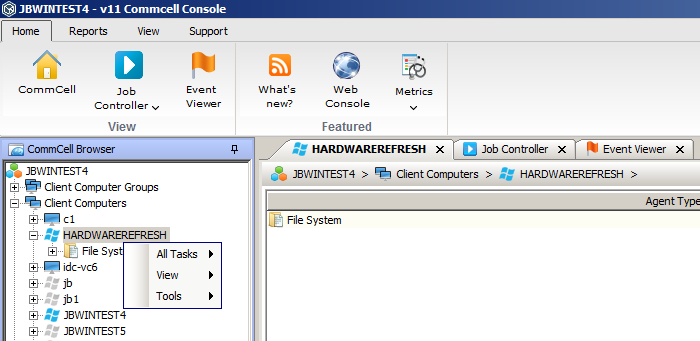You can perform advanced operations in the CommCell Console such as hiding CommCell elements and disconnecting a user from the CommCell environment.
Hiding CommCell Elements
Applies To: CommCell Console, Command Center
In the CommCell Console, you can hide features and options from the restricted user group. For example, certain users do not need access to all options in the CommCell, particularly administrative functions. In the Command Center, you can set navigation preferences for the restricted user group.
The CV_Restricted_Visibility user group must be created to hide CommCell elements from selected users. When assigned to this user group, members can see only a portion of all available options in the CommCell. The following elements are excluded from the restricted view of the CommCell Console:
-
Tools menu
-
Toolbar buttons including Alert, Scheduler, Control Panel, and Web Console
-
CommCell Browser nodes including Security, Storage Resources, Policies, Content Director, and Workflows
-
At the CommCell root node, the right-click menu and all related options
-
At the Client Computers node, all options on the right-click menu, except for Customize View
-
At each client computer node, the Properties and Send Log Files options on the right-click menu
The following elements are included in the restricted view of the CommCell Console:
-
Menus including Home, Reports, View, and Support.
-
Toolbar buttons including CommCell, Job Controller, Event Viewer, What's New, and Getting Started
-
CommCell Browser nodes including the CommCell root node, Client Computers, and Reports
-
The Customize View option on the right-click menu of the Client Computers node
-
All options on the right-click menu for each client computer node, except for Properties and Send Log Files
Use the following steps to hide CommCell elements from selected users.
-
From the CommCell Browser, right-click the CommCell root node, then select Properties.
-
In the CommCell Properties dialog box, select the Additional Settings tab and click Add.
-
In the Name box, type nRestrictedViewEnabled.
Once entered, the Category and Type details will be automatically populated.
-
In the Value box, type 2.
-
Click OK.
-
Click OK to close the Properties dialog box.
-
Restart the CommCell services.
When the CommCell services restart, the CV_Restricted_Visibility user group will appear under the Security > CommCell User Groups node.
-
From the CommCell Browser, go to Security > CommCell User Groups.
-
Right-click the CV_Restricted_Visibility user group and then click Properties.
-
In the Users tab, move users that should have the restricted view from the Available Users list to the Member Users list.
Important
Ensure that you assign a user to at least one other user group (for example, View All user group), otherwise that user will not be able to access the CommCell Console.
After a user is added to the CV_Restricted_Visibility user group, the user has a restricted view of the CommCell Console as shown:

Alerts
An alert can be configured to send e-mail notifications to user groups created from within the CommCell Console as well as external domain user groups. However, individual external domain users will not receive the alert notification e-mail if they have not previously logged on to the CommCell Console. Users (from the user groups created from within the CommCell Console) will receive the alert e-mail notification regardless of their login status.
Reports
A scheduled report can be configured to be sent via e-mail to user groups created from within the CommCell Console as well as external domain user groups. However, individual external domain users will not receive the report via e-mail if they have not previously logged on to the CommCell Console. Users (from the user groups created from within the CommCell Console) will receive the report e-mail regardless of their login status.
Property Sheet Warning
When a user opens a property sheet (dialog box) that is already opened by another user, an overwrite warning appears. The warning includes the name of the other user. If all of the users make changes to the property sheet, only the changes made by the last user are saved.